Index CHEVROLET EXPRESS 1997 1.G Repair Manual
[x] Cancel search | Manufacturer: CHEVROLET, Model Year: 1997, Model line: EXPRESS, Model: CHEVROLET EXPRESS 1997 1.GPages: 386, PDF Size: 20.32 MB
Page 290 of 386
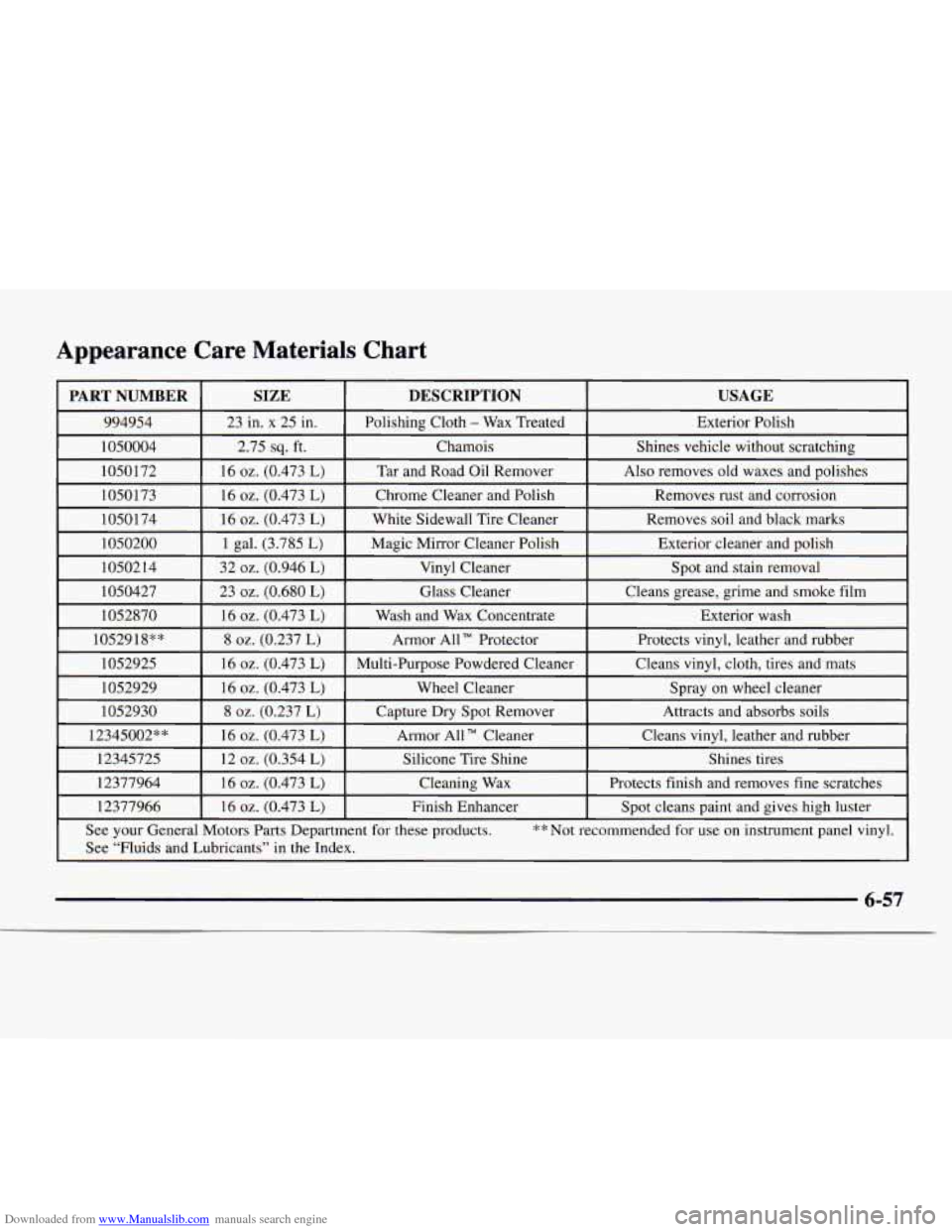
Downloaded from www.Manualslib.com manuals search engine Appearance Care Materials Chart
PART NUMBER DESCRIPTION USAGE
1052929
Cleans vinyl, leather and rubber
Armor All
TM Cleaner
16 oz. (0.473 L) 12345002”” Attracts and
absorbs soils Capture
Dry Spot Remover
8 oz. (0.237 L)
1052930 Spray on wheel
cleaner
Wheel Cleaner 16
oz. (0.473 L)
12345725 Spot cleans paint and gives high luster Finish
Enhancer 16
oz. (0.473 L) 12377966 Protects finish
and removes fine scratches
Cleaning Wax
16
oz. (0.473 L)
12377964 Shines tires Silicone
Tire Shine
12
oz. (0.354 L)
See your General Motors Parts Department for these products.
** Not recommended for use on instrument panel vinyl.
See “Fluids and Lubricants” in the Index.
6-57
Page 292 of 386
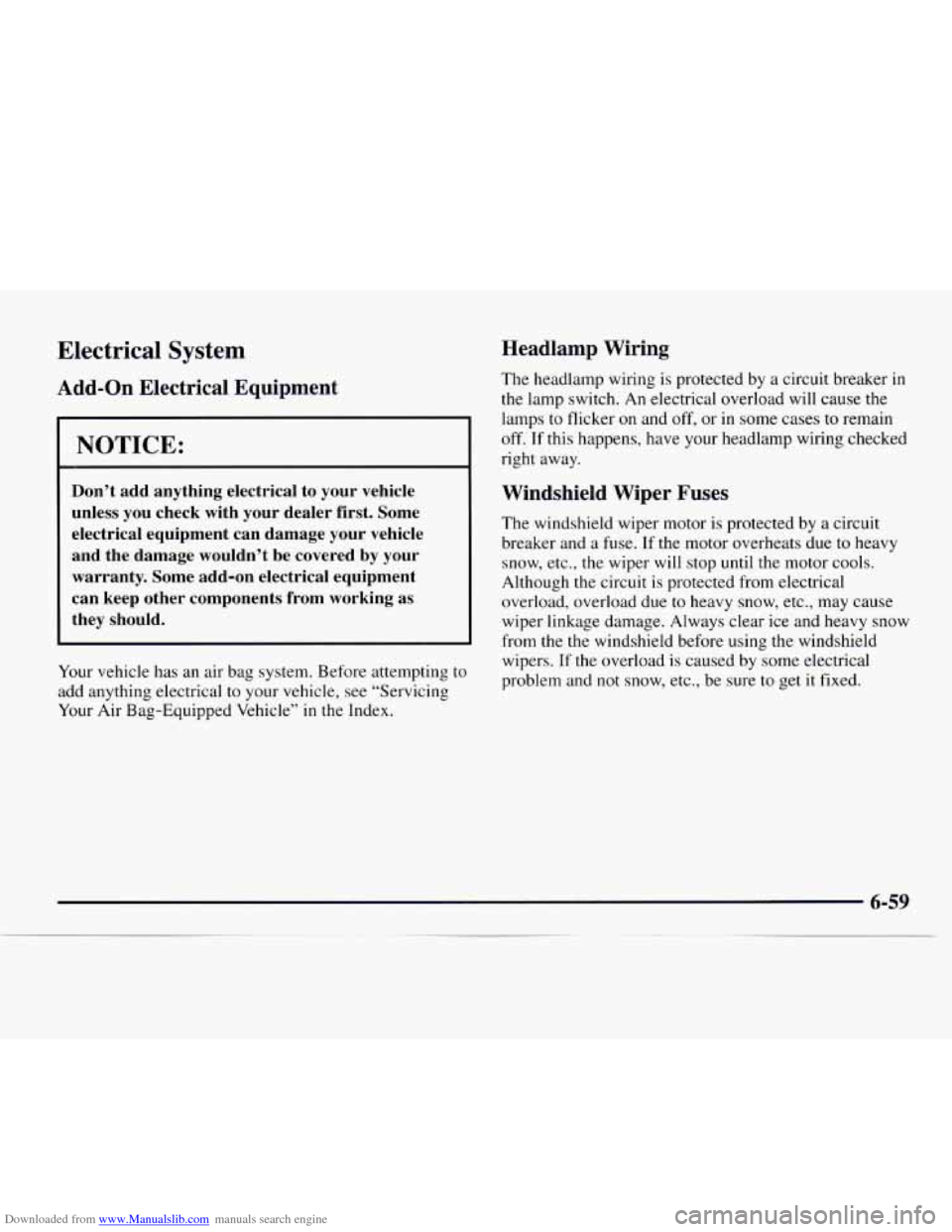
Downloaded from www.Manualslib.com manuals search engine Electrical System
Add-on Electrical Equipment
I NOTICE:
Don’t add anything electrical to your vehicle
unless you check with your dealer first. Some
electrical equipment can damage your vehicle
and the damage wouldn’t be covered
by your
warranty. Some add-on electrical equipment
can keep other components from working as
they should.
Your vehicle has an air bag system. Before attempting to
add anything electrical to your vehicle, see “Servicing
Your Air Bag-Equipped Vehicle”
in the Index.
Headlamp Wiring
The headlamp wiring is protected by a circuit breaker in
the lamp switch. An electrical overload will cause the
lamps to flicker on and
off, or in some cases to remain
off. If this happens, have your headlamp wiring checked
right away.
Windshield Wiper Fuses
The windshield wiper motor is protected by a circuit
breaker and a fuse.
If the motor overheats due to heavy
snow, etc., the wiper will stop until the motor cools.
Although the circuit is protected from electrical
overload, overload due
to heavy snow, etc., may cause
wiper linkage damage. Always clear ice and heavy snow
from the the windshield before using the windshield
wipers.
If the overload is caused by some electrical
problem and
not snow, etc., be sure to get it fixed.
Page 293 of 386
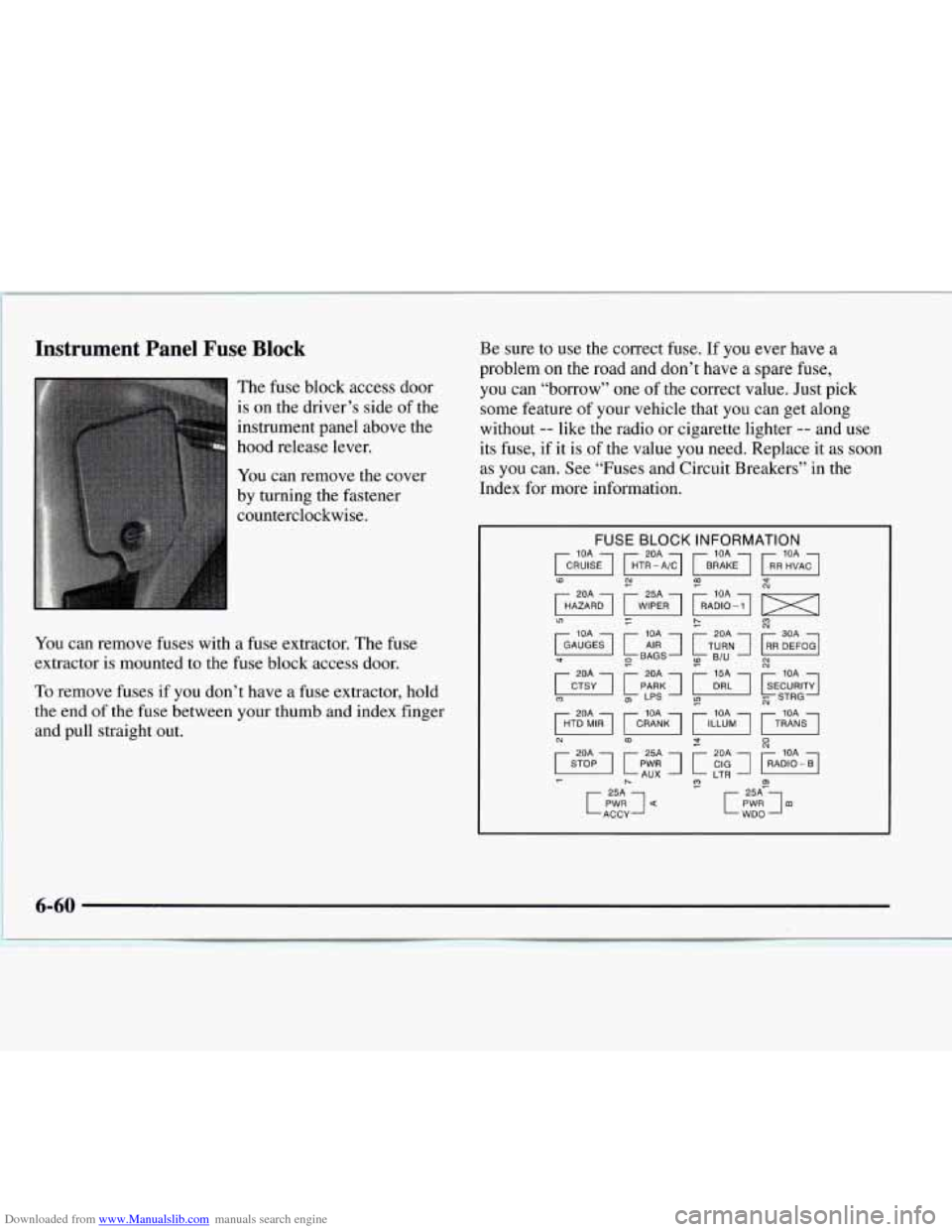
Downloaded from www.Manualslib.com manuals search engine Instrument Panel Fuse Block
The fuse block access door
is on the driver's side of the
instrument panel above the
hood release lever.
You can remove the cover
by turning the fastener
counterclockwise.
You can remove fuses with a fuse extractor. The fuse
extractor
is mounted to the fuse block access door.
To remove fuses if you don't have a fuse extractor, hold
the end of the fuse between your thumb and index finger
and pull straight out. Be sure to use
the correct fuse.
If you ever have a
problem on the road and don't have a spare fuse,
you can "borrow" one of the correct value. Just pick
some feature of your vehicle that you can get along
without
-- like the radio or cigarette lighter -- and use
its fuse, if it is of the value you need. Replace it
as soon
as you can. See "Fuses and Circuit Breakers'' in the
Index for more information.
6-60
Page 306 of 386
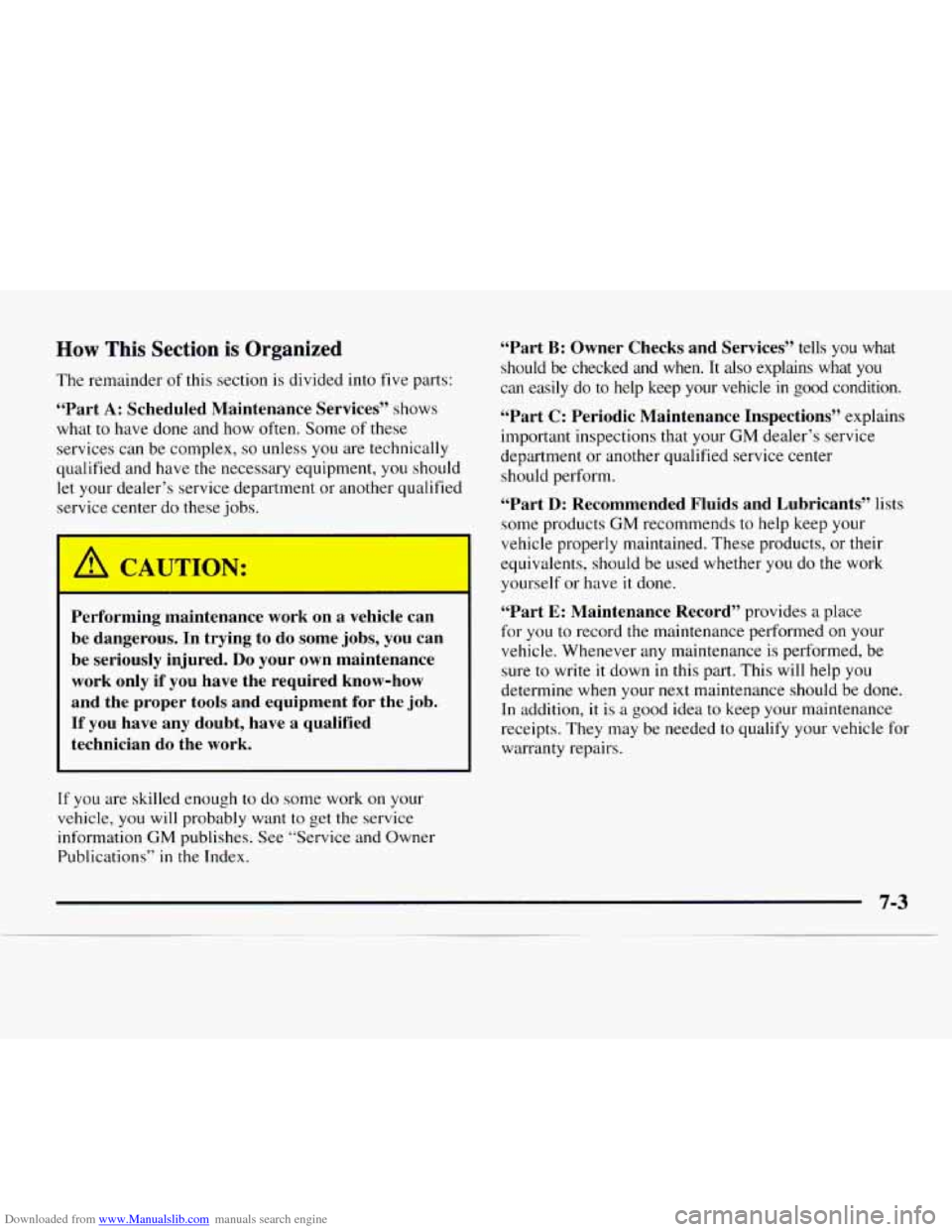
Downloaded from www.Manualslib.com manuals search engine How This Section is Organized
The remainder of this section is divided into five parts:
“Part A: Scheduled Maintenance Services” shows
what
to have done and how often. Some of these
services can be complex,
so unless you are technically
qualified and have the necessary equipment, you should
let your dealer’s service department or another qualified
service center do these jobs.
Performing maintenance work on a vehicle can
be dangerous. In trying to do some jobs, you can
be seriously injured.
Do your own maintenance
work only if you have the required know-how
and the proper tools and equipment for the job.
If you have any doubt, have a qualified
technician do the work.
If you are skilled enough to do some work on your
vehicle,
you will probably want to get the service
information GM publishes. See “Service and Owner
Publications’’
in the Index.
“Part B: Owner Checks and Services” tells you what
should be checked and when. It also explains what you
can easily do to help keep your vehicle
in good condition.
“Part C: Periodic Maintenance Inspections” explains
important inspections that your GM dealer’s service
department or another qualified service center
should perform.
“Part D: Recommended Fluids and Lubricants” lists
some products GM recommends to help keep your
vehicle properly maintained. These products, or their
equivalents, should be used whether
you do the work
yourself or have
it done.
“Part E: Maintenance Record’’ provides a place
for you to record the maintenance performed on your
vehicle. Whenever any maintenance is performed, be
sure to write it down
in this part. This will help you
determine when your next maintenance should be done.
In addition, it
is a good idea to keep your maintenance
receipts. They may be needed
to qualify your vehicle for
warranty repairs.
Page 307 of 386
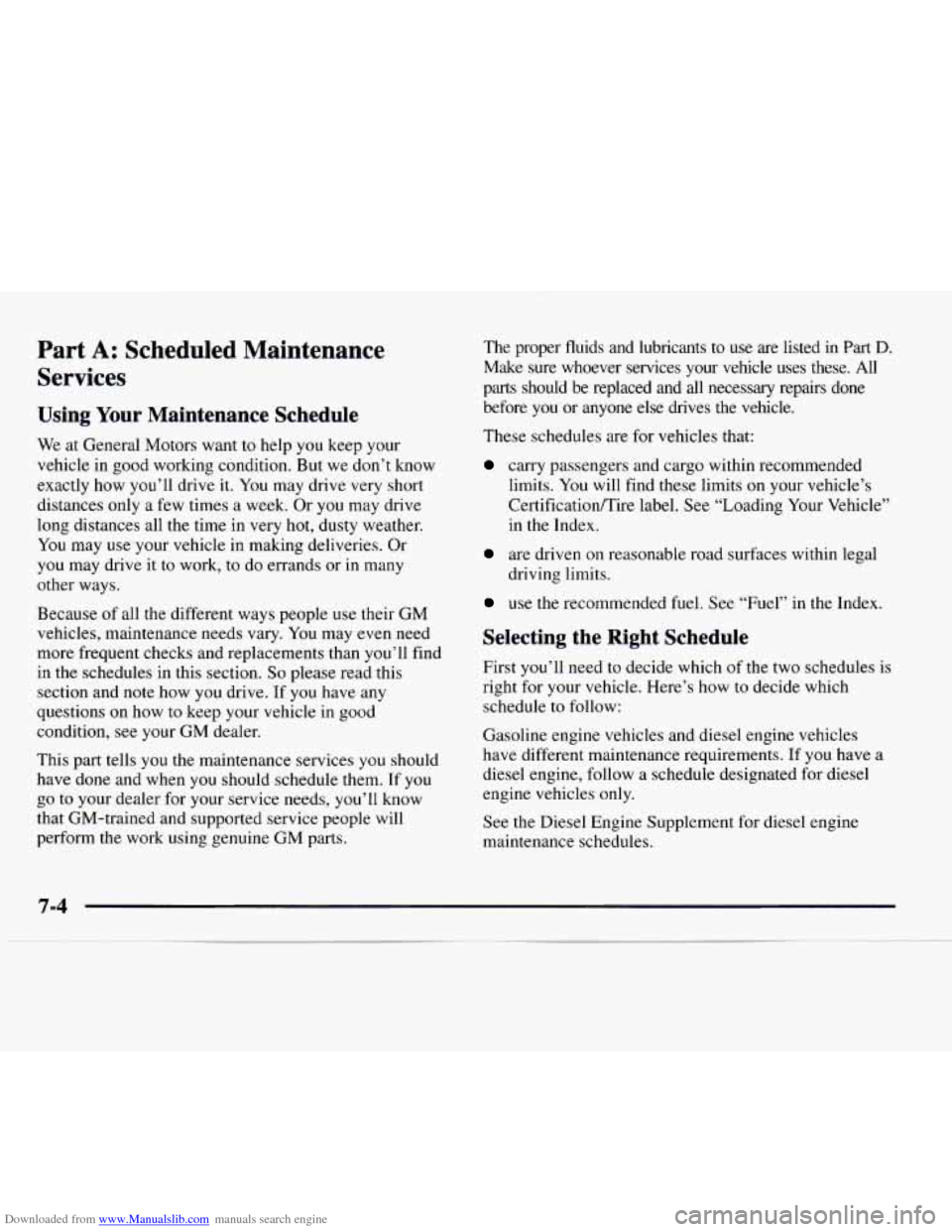
Downloaded from www.Manualslib.com manuals search engine Part A: Scheduled Maintenance
Services
Using Your Maintenance ‘Schedule
We at General Motors want to help you keep your
vehicle in good working condition. But we don’t know
exactly how you’ll drive it. You may drive very short
distances only
a few times a week. Or you may drive
long distances all the time in very hot, dusty weather.
You may use your vehicle in making deliveries. Or
you may drive it to work, to do errands or in many
other ways.
Because of all the different ways people use their GM
vehicles, maintenance needs vary. You may even need
more frequent checks and replacements than you’ll find
in the schedules in this section.
So please read this
section and note how you drive.
If you have any
questions
on how to keep your vehicle in good
condition, see your
GM dealer.
This part tells you the maintenance services you should
have done and when you should schedule them. If
you
go to your dealer for your service needs, you’ll know
that GM-trained and supported service people will
perform the work using genuine GM parts. The proper fluids and lubricants
to use are listed in
Part D.
Make sure whoever services your vehicle uses these. All
parts should be replaced and all necessary repairs done
before
you or anyone else drives the vehicle.
These schedules are for vehicles that:
carry passengers and cargo within recommended
limits. You will find these limits on your vehicle’s
CertificatiodTire label. See “Loading Your Vehicle”
in the Index.
are driven on reasonable road surfaces within legal
driving limits.
use the recommended fuel. See “Fuel” in the Index.
Selecting the Right Schedule
First you’ll need to decide which of the two schedules is
right for your vehicle. Here’s how
to decide which
schedule
to follow:
Gasoline engine vehicles and diesel engine vehicles
have different maintenance requirements. If you have a
diesel engine, follow a schedule designated for diesel
engine vehicles only.
See the Diesel Engine Supplement for diesel engine
maintenance schedules.
Page 311 of 386
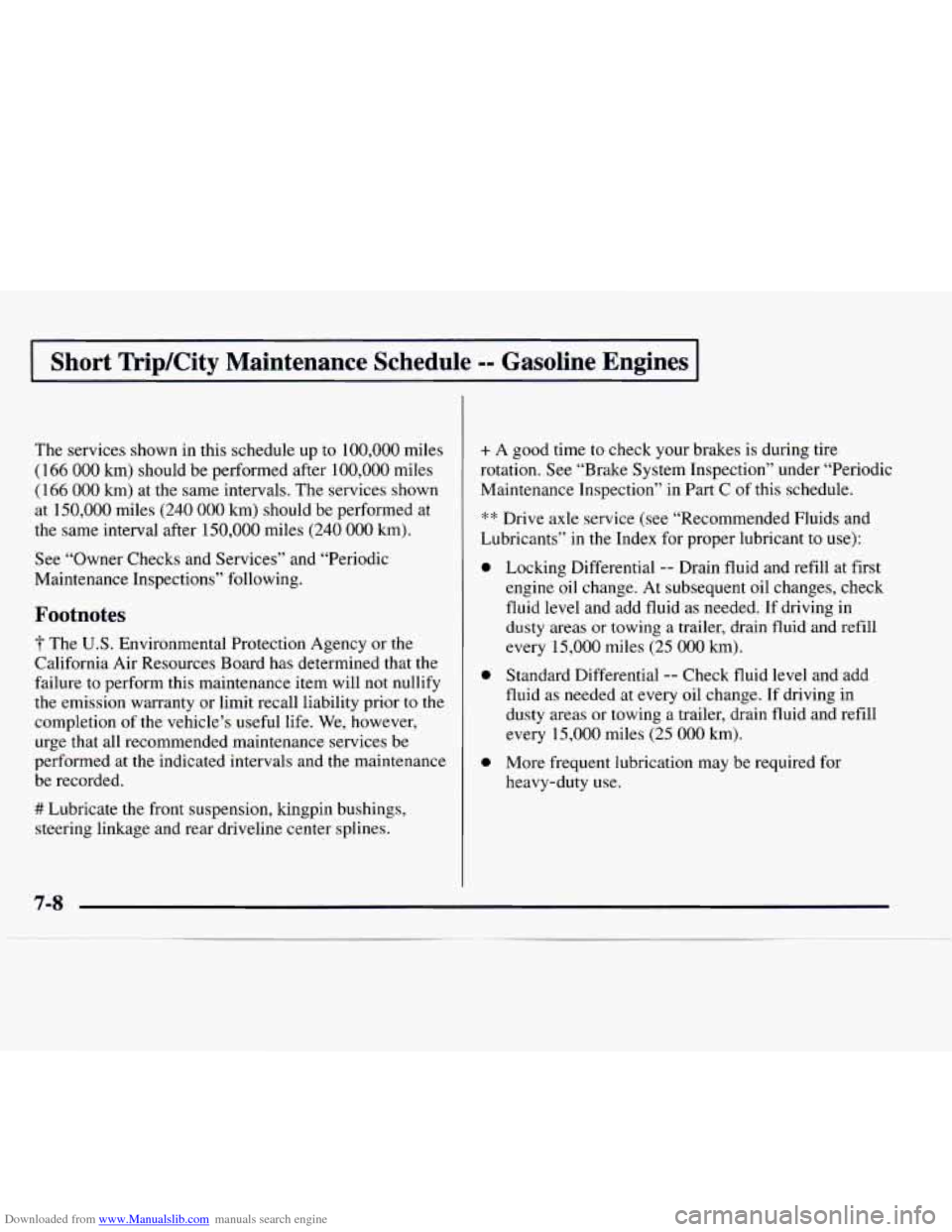
Downloaded from www.Manualslib.com manuals search engine I Short TripKity Maintenance Schedule =- Gasoline Engines I
The services shown in this schedule up to 100,000 miles
(1 66 000 km) should be performed after 100,000 miles
(166
000 km) at the same intervals. The services shown
at 150,000 miles
(240 000 km) should be performed at
the same interval after 150,000 miles (240 000 km).
See “Owner Checks and Services” and “Periodic
Maintenance Inspections” following.
Footnotes
3- The U.S. Environmental Protection Agency or the
California Air Resources Board has determined that the
failure to perform this maintenance item will
not nullify
the emission warranty or limit recall liability prior
to the
completion of the vehicle’s useful life. We, however,
urge that all recommended maintenance services be
performed at the indicated intervals and the maintenance
be recorded.
# Lubricate the front suspension, kingpin bushings,
steering linkage and rear driveline center splines.
+ A good time to check your brakes is during tire
rotation. See “Brake System Inspection’’ under “Periodic
Maintenance Inspection’’ in Part
C of this schedule.
** Drive axle service (see “Recommended Fluids and
Lubricants’’
in the Index for proper lubricant to use):
0
0
0
Locking Differential -- Drain fluid and refill at first
engine
oil change. At subsequent oil changes, check
fluid level and add fluid as needed.
If driving in
dusty areas or towing a trailer, drain fluid and refill
every 15,000 miles (25
000 km).
Standard Differential
-- Check fluid level and add
fluid as needed at every oil change. If driving in
dusty areas or towing a trailer, drain fluid and refill
every
15,000 miles (25 000 km).
More frequent lubrication may be required for
heavy-duty use.
Page 312 of 386
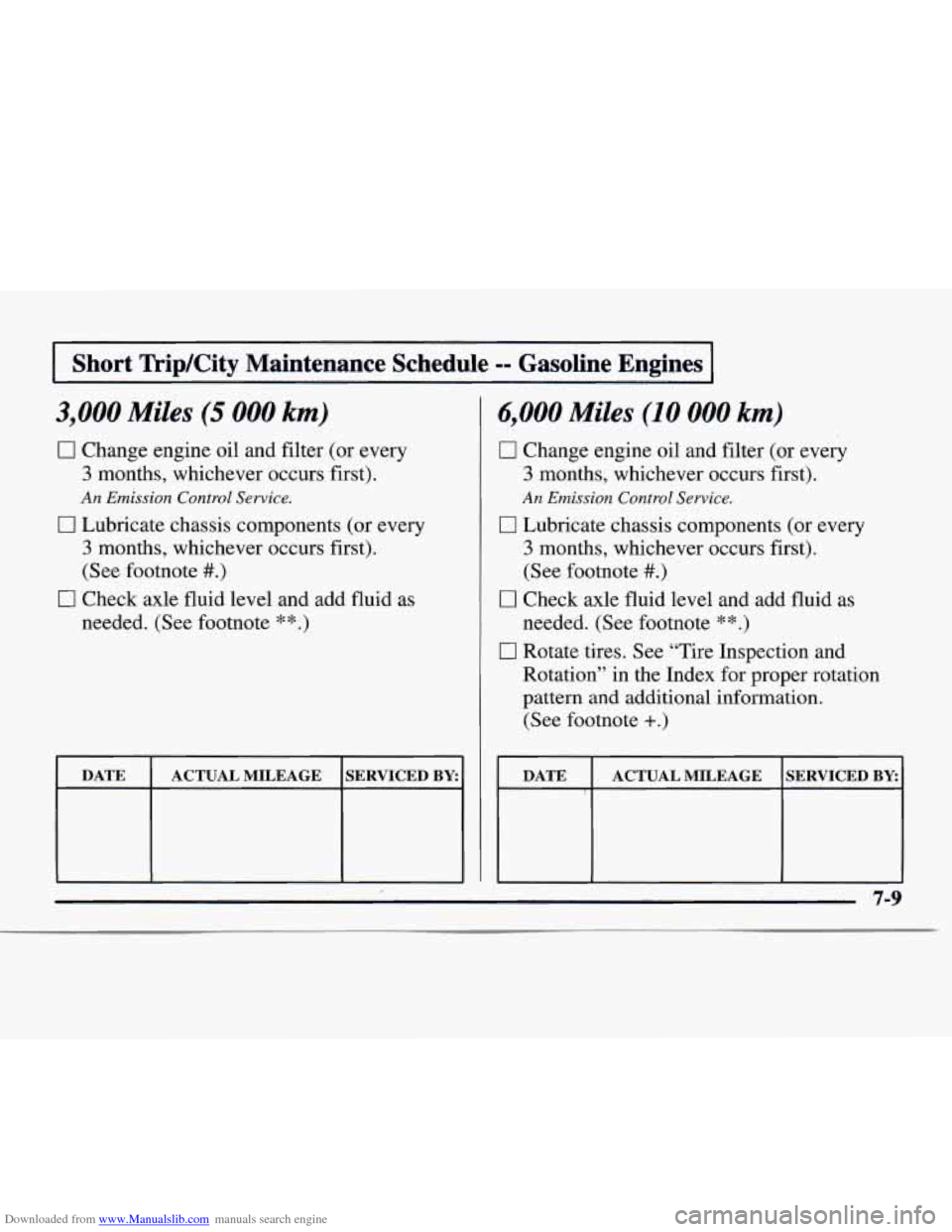
Downloaded from www.Manualslib.com manuals search engine I Short Trip/City Maintenance Schedule -- Gasoline Engines I
3,000 Miles (5 000 km)
0 Change engine oil and filter (or every
3 months, whichever occurs first).
An Emission Control Service.
0 Lubricate chassis components (or every
3 months, whichever occurs first).
(See footnote
#.)
0 Check axle fluid level and add fluid as
needed. (See footnote
** .)
DATE SERVICED BY ACTUAL MILEAGE
6,000 Miles (10 000 km)
0 Change engine oil and filter (or every
3 months, whichever occurs first).
An Emission Control Service.
0 Lubricate chassis components (or every
3 months, whichever occurs first).
(See footnote
#.)
0 Check axle fluid level and add fluid as
needed. (See footnote
**.)
0 Rotate tires. See “Tire Inspection and
Rotation” in the Index for proper rotation
pattern and additional information.
(See footnote
+.)
DATE SERVICED BY: ACTUAL MILEAGE
7-9
Page 313 of 386
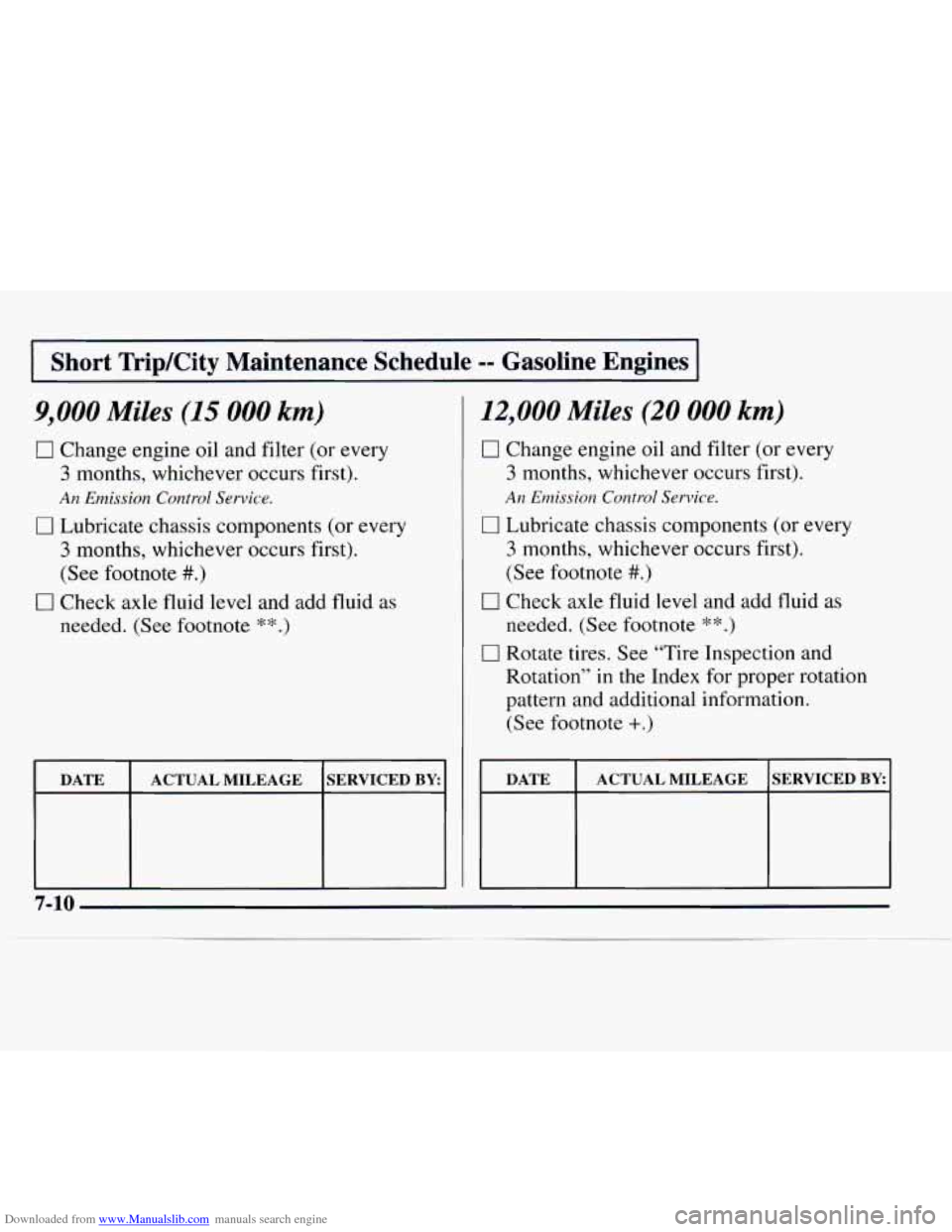
Downloaded from www.Manualslib.com manuals search engine I Short TripKity Maintenance Schedule == Gasoline Engines I
9,000 Miles (15 000 km)
0 Change engine oil and filter (or every
3 months, whichever occurs first).
An Emission Control Service.
0 Lubricate chassis components (or every
3 months, whichever occurs first).
(See footnote
#.)
0 Check axle fluid level and add fluid as
needed. (See footnote
**.)
DATE
SERVICED BY ACTUAL MILEAGE
12,000 Miles (20 000 km)
0 Change engine oil and filter (or every
3 months, whichever occurs first).
An Emission Control Service.
0 Lubricate chassis components (or every
3 months, whichever occurs first).
(See footnote
#.)
0 Check axle fluid level and add fluid as
needed. (See footnote
**.)
0 Rotate tires. See “Tire Inspection and
Rotation”
in the Index for proper rotation
pattern and additional information.
(See footnote
+.)
DATE SERVICED BY ACTUAL MILEAGE
I I I
7-10
Page 315 of 386
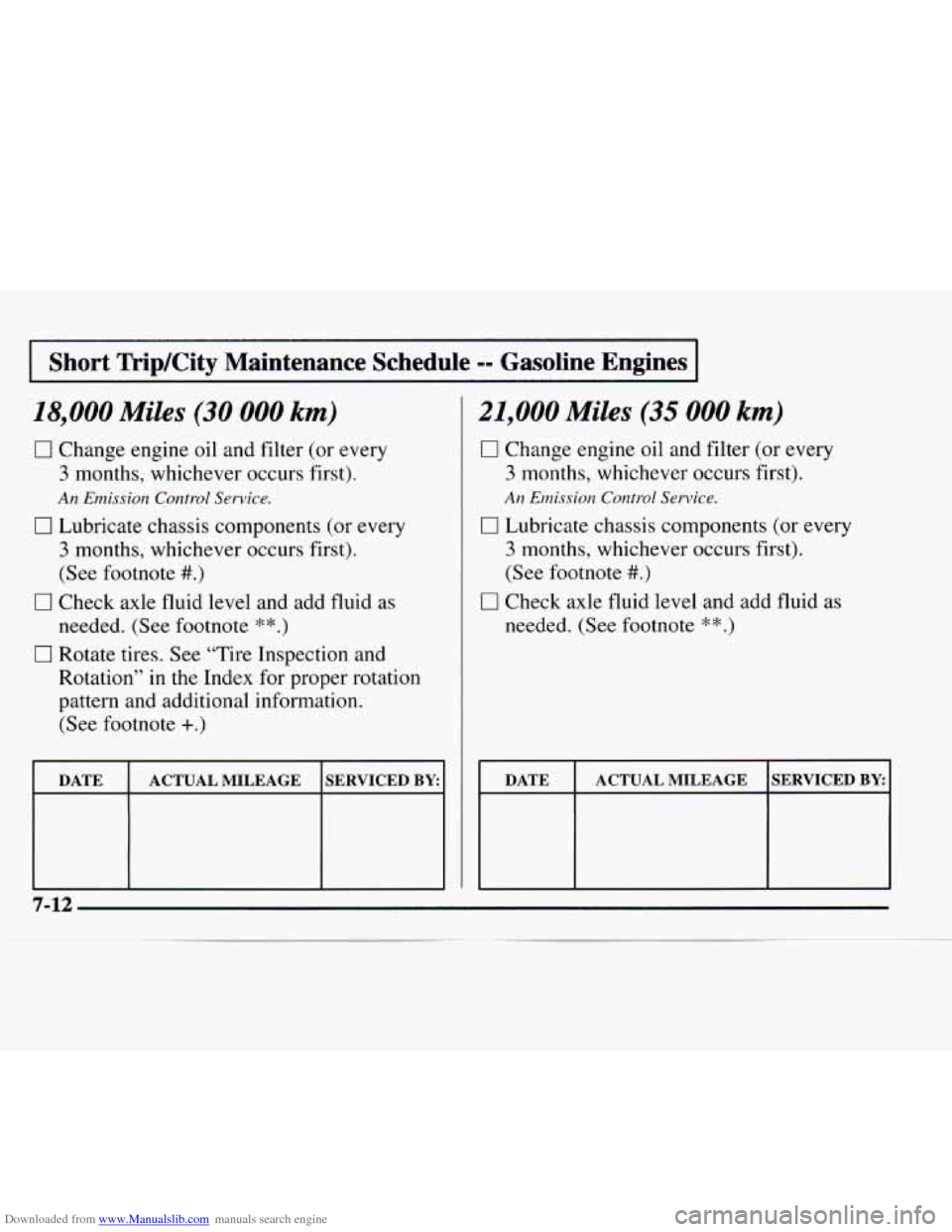
Downloaded from www.Manualslib.com manuals search engine I Short TripKity Maintenance Schedule =- Gasoline Engines I
18,000 Miles (30 000 km)
0 Change engine oil and filter (or every
3 months, whichever occurs first).
An Emission Control Service.
0 Lubricate chassis components (or every
3 months, whichever occurs first).
(See footnote
#.)
0 Check axle fluid level and add fluid as
needed. (See footnote
**.)
0 Rotate tires. See “Tire Inspection and
Rotation”
in the Index for proper rotation
pattern and additional information.
(See footnote
+.)
SERVICED BY
21,000 Miles (35 000 km)
0 Change engine oil and filter (or every
3 months, whichever occurs first).
AFI E;?zission Control Service.
0 Lubricate chassis components (or every
3 months, whichever occurs first).
(See footnote
#.)
0 Check axle fluid level and add fluid as
needed. (See footnote
** .)
DATE ACTUAL MILEAGE SERVICED BY:
7-12
Page 316 of 386
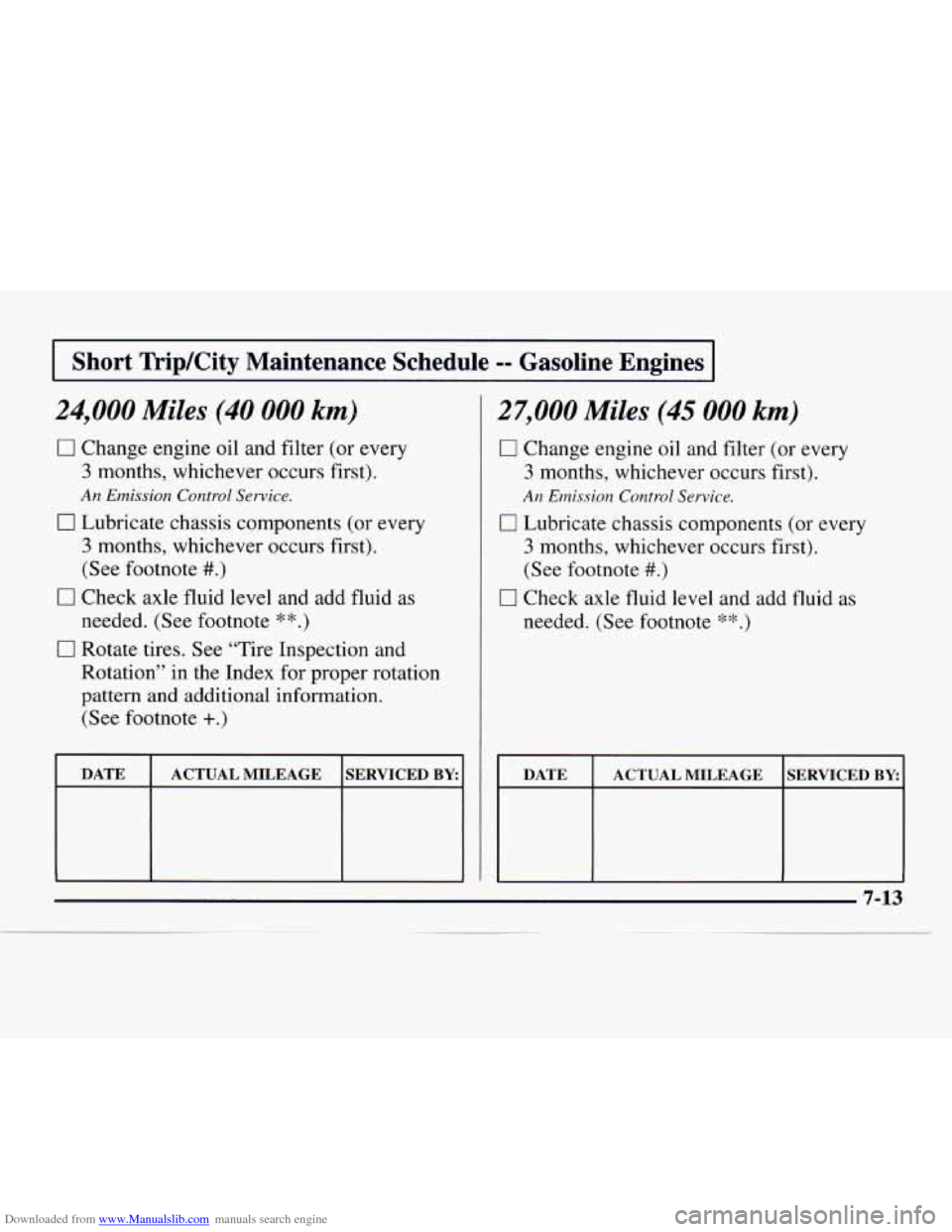
Downloaded from www.Manualslib.com manuals search engine I Short TripKity Maintenance Schedule -- Gasoline Engines I
24,000 Miles (40 000 km)
0 Change engine oil and filter (or every
3 months, whichever occurs first).
An Emission Control Service.
0 Lubricate chassis components (or every
3 months, whichever occurs first).
(See footnote
#.)
0 Check axle fluid level and add fluid as
needed. (See footnote
* *.)
0 Rotate tires. See “Tire Inspection and
Rotation” in the Index for proper rotation
pattern and additional information.
(See footnote
+.)
27,000 Miles (45 000 km)
0 Change engine oil and filter (or every
3 months, whichever occurs first).
An Emission Control Service.
0 Lubricate chassis components (or every
3 months, whichever occurs first).
(See footnote
#.)
0 Check axle fluid level and add fluid as
needed. (See footnote
**.)
~ ~ ~ ~~~~ ~
DATE
SERVICED BY: ACTUAL MILEAGE